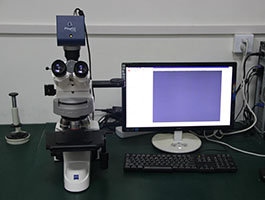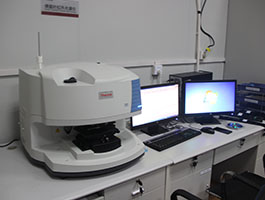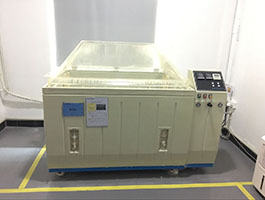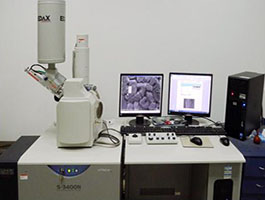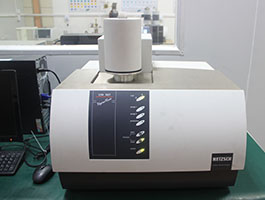It is a technology to measure the physical properties of the materials with the temperature variation under the condition of controlling temperature by the program.
(3).png)
The Purpose of the Material Thermal Analysis:
Thermal Analysis is to measure the variation of the physical property under the process of heating or cooling, to study the variation of the physical property, or make the identify and fractal for the materials. Physical properties includes the properties of quality, temperature, enthalpy, size, machinery, acoustics, electricity , magnetics, etc.
The Significance of Thermal Analysis:
It is widely applied to characterization material’ s thermal property, physical property, mechanical property, and stability, etc. Besides, it plays important and realistic role on the development of the material and quality control in the production.
Commonly used methods of Thermal Analysis:
There are many kinds of Thermal Analyses. According to the induction and classification of the ICTA, there are totally 9 categories and 17 different types. Among the technologies of the Thermal Analysis, thermo-gravimetry, differential thermal analysis, differential scanning calorimetry, thermo-mechanical analysis, steady state thermal flow method, laser flash method are widely used.
(3).png)
Thermo Gravimetric Analysis(TGA)
Under the process of temperature variation(up/down/ constant temperature), it is to measure the whole changing process of the weight with the variation of the temperature and time.
By Thermo-gravimetric Analysis, we can test the stability and oxidation stability of the materials in different situations, make analyses towards the materialization process of resolving, adsorption, desorption, oxidation, restoring(including the further study on Apparent Reaction Kinetics by using the result of TG), make quantitative calculation of material content, and measure moisture, volatile component and the content of all kinds of additives and fillers.
This method can be widely applied to the development, process optimization and quality control of plastic, rubber, coating, medicine, catalyzer, inorganic material, metal material, composite, etc.
The Curve Analysis of the Thermo-gravimetric Experiment
TGA Analysis Curve:
(4).png)
Thermal Cracking Temperature
(4).png)
Composition analysis of polymer
Thermo-mechanical Analysis (TMA)
Thermo-mechanical Analysis (TMA) can be widely applied to the industries of plastic polymer, ceramic, metal, building material, fire-proof material, composite, etc. The fundamental principles of this method is, under the process of certain loading condition and temperature program (up/down/ constant temperature or different combinations), to measure the deformation of the sample. By the Thermo-mechanical Analyzer, we can study on following properties of the material:
linear expansion and shrink
glass transition temperature
Densification and sintering process
heat processing optimization
the test of softening point
phase transition process
Reaction Kinetics
The Curve Analysis of TMA
(5).png)
Thermal Expansion Measurement
(5).png)
Board time of PCB
Differential Scanning Calorimetry(DSC)
It is to measure the heat flux differential changes between sample and reference under the process of temperature variation(up/down/constant temperature).
By Differential Scanning Calorimeter, we can study on materials’ melting and crystallization process, degree of crystallinity , glass transition, phase transformation, liquid crystalline transition, oxidation stability(oxidation induction time(OIT)), reaction temperature and reaction enthalpy, measure materials’ specific heat and purity, study on the compatibility of polymer blend, the curing process of thermosetting resin, and make reaction kinetics study, etc. This method can be widely applied to the industries of plastic, rubber, fiber, coating, adhesive, medicine, food, biological organism , inorganic material, metal material, composite, etc.
The Test Curve Analysis of DSC
(6).png)
Glass-transition Temperature
(6).png)
Melting point
(5).png)
crystallization temperature
Dynamic Mechanical Analysis (DMA)
It is to make the sample under the temperature controlled by the program, adding single frequency or multiple frequency oscillating force, to study the mechanical behavior of the sample, measure the function relationship in storage modulus, loss modulus and loss factor with the change of temperature, time and the frequency of the force. It is widely applied to the industries of thermoplastic and thermosetting plastic, rubber, coating, metal and alloy, inorganic material, composite, etc.
DMA Typical Application
1.rigidity(E’)
2.damping force characteristic (E”, tgδ)
3.creep and stress relaxation
4.hysteresis and internal friction
5.glass transition
6.phase transition
7.Softening temperature
8.secondary relaxation
9.solidification process
The Deformation Pattern of DMA
(7).png) |
(7).png) |
(6).png) |
||||
| Three Point Bending | Single and Double Cantilever | Stretch | ||||
|
||||||
The Typical Chart of DMA
(10).png)
The Typical Chart 1 of DMA
(1).png)
The Typical Chart 2 of DMA
Thermal Conductivity
1. The steady-state heat flow method
Scope of application: applicable to homogeneous and heterogeneous electric insulation of thermal conductivity of the thermal interface materials of equivalent heat transfer coefficient and thermal impedance test, such as: thermal conductive paste, thermal conductivity, heat conduction glue, interface material, phase change material, ceramic, metal, base plate, aluminum plate, copper base board, soft board, etc. Measuring range: the coefficient of thermal conductivity 0.1 ~ 20 W/(m • K), thermal impedance > 0.01 ℃, W/cm2
Reference Standard:
ASTM D5470-12 thermal conductivity electrical insulation heat transfer characteristics of the standard test methods
Sample requirements:
Steady state method usually require sample homogeneous structure, dry, flat, smooth surface. Solid sample size requirements: < 27 mm x 27 mm, thickness 5 mm
Test case
(8).png)
2. Laser indeed method (LFA)
Laser indeed method can be applied to a wide range of materials, including graphite, metal, ceramics, polymers, composite materials, such as wide range of measuring temperature (room temperature to 500 ℃), the measurement range of 0.1 ~ 2000 W/(m • K). This method is a non-contact and non-destructive measurement technology, with a simple sample preparation, the required sample size is small, measuring speed, numerous advantages of higher accuracy. Not only can accurately measure the thermal diffusion coefficient directly, can also be multiplied by the density and specific heat capacity of samples, coefficient of thermal conductivity calculation.
Reference Standard:
ASTM E1461-13 test method for determination of thermal diffusivity by flash method
Sample requirements:
Samples of internal should be uniform, parallel to the surface must be smooth, uniform thickness.
Test case
(8).png)

(3).png)
(2).png)
